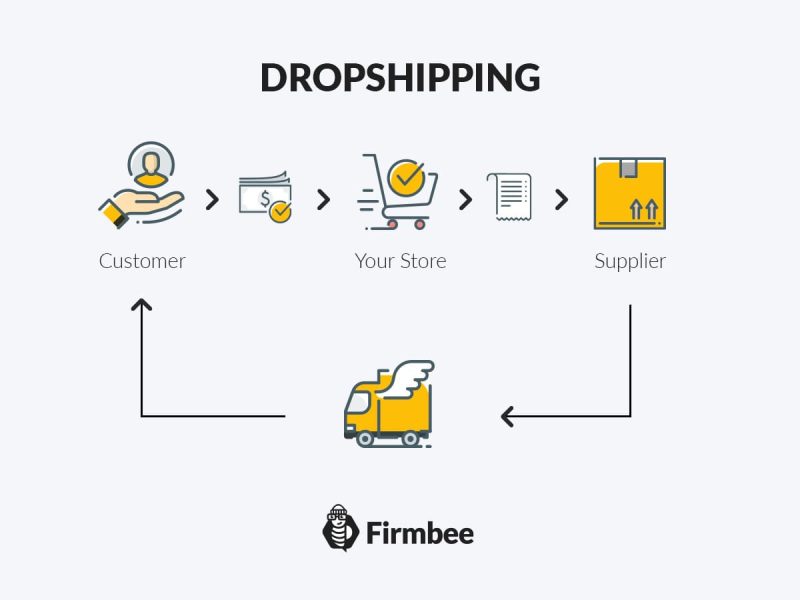Dropshipping and third-party fulfillment are the forms of fulfillment methods used in e-commerce. Starting a new company comes with the apprehension that not everything may go well. We ask ourselves: would it be successful? Will I have enough financial resources to stay on the market? New entrepreneurs search for solutions that will allow them to save money without having to make any radical decisions. Outsourcing logistic processes in form of dropshipping and third-party fulfillment are one of the most beneficial solutions for beginning entrepreneurs.
Dropshipping and third-party fulfillment – table of contents:
- Dropshipping – two models
- The risk of dropshipping
- Third-party fulfillment
- Advantages and disadvantages of third-party fulfillment
- Third-party fulfillment and dropshipping
- Summary
Dropshipping – two models
Generally, the idea of dropshipping means that for our operations the storage is being rented. There are three parties in the transaction – seller, buyer, and the store owner (usually the dealer, wholesaler, or producer of the item). The transaction starts with the contact of the buyer and the seller and ends up at the moment of product delivery. What is important, the seller has no access to the physical items that are being purchased. The item is being delivered to the buyer by the dealer.
Dropshipping has two different variations accordingly to the type of activity of the seller. In the first model, the seller provides services of intermediation, which means that the seller deals with searching for clients and entering into the transaction, but he doesn’t deal with the purchase of the product. The mere sales transaction – both formally and in terms of delivery is being made between the dealer and the buyer.

In the second model, the seller is involved in the trade in goods. His activity reminds the typical, standard running of the shop – he purchases goods and sells them to clients. There is one difference, here the seller doesn’t have direct contact with the product and commissions the delivery to the dealer, who delivers the goods directly to the buyers.
The risk of dropshipping
The main advantage of dropshipping is its convenience and cost-efficiency in comparison to the distribution made by the company itself.
There are a lot of savings related to the fact that the company doesn’t have its storage such as: renting costs, price of materials needed for shipping, and salaries of employees working in the storage. The cost of storage is even higher in the case of specific materials such as foodstuff or chemicals that require special conditions for storing.
Dropshipping means savings of time and energy related to delivery management: preparation of parcels, and stock control. Such processes are difficult to manage especially at the beginning of own business running when the entrepreneur works usually alone.
When deciding to use dropshipping method one should remember about risks. First and foremost special attention should be paid to the possibilities of our own company to spot the moment when drop shipping will be unnecessary. It is worth being ready for the time when our company will stop being dependent on others. Additionally, when choosing a contractor to cooperate there one needs to do everything to find a trustworthy, competent dealer, who can guarantee high-quality products and high-quality delivery. It is important because a product that is not consistent with the agreement, the same as messy delivery damage the reputation of the dealer and the seller.
Third-party fulfillment
Third-party fulfillment is a type of delivery that is being realized by the external company. The external company is responsible for the part of the whole (depending on the model chosen) process of order handling. Practically it all means that the seller doesn’t have to worry about the reception from the supplier, delivery to the client, handling complaints and returns, or contact with clients. All those services are dealt with by the external company.
Seller doesn’t have to pay for storage of the stock – there are costs of storage renting, machinery, amortization, or staff employment.

Advantages and disadvantages of third-party fulfillment
The main advantages of third-party fulfillment are:
- Seller doesn’t pay for storage of products.
- Seller pays only for the surface he uses.
- The third-party service provider takes full responsibility for the conditions of storage (temperature, safety, humidity).
- Orders can be wrapped individually, and personalized tickets may be added easily.
- Sellers save on delivery costs – third-party service providers have better standing to negotiate prices with delivery companies.
- E-commerce systems can be integrated with storage systems – all the processes can be monitored.
- Seller saves time – his company doesn’t have to deal with servicing orders and can focus on promotional activities of its store.
The main disadvantages of third-party fulfillment are:
- Third-party fulfillment like any other service is not free.
- Some third-party service providers require to pay for the minimum number of orders to start cooperation.
- The loyalty and truthfulness of the service provider are particularly important since his operations influence directly the brand image of the company among the clients.
Third-party fulfillment and dropshipping
Dropshipping is a model of fulfillment, in which the store acts as an intermediary and charges a small fee for each item sold. The store is responsible for order processing, but the product is being sent from the storage of the distributor.
The main difference between a third-party fulfillment and dropshipping is that the third-party store is the owner of the product and only hires a storage space, where the product is being kept, while in the case of dropshipping the assortment doesn’t belong to the store.
Summary
The selection of the fulfillment method is a matter of choice. It is good to know about all pros and cons of both types of fulfillment. Some store owners decide to combine both options. It is not easy, but the results are very satisfactory.
Read also: 4 basic business models in e-commerce
If you like our content, join our busy bees community on Facebook, Twitter, LinkedIn, Instagram, YouTube, Pinterest.
Author: Martin Sparks
E-commerce enthusiasts which constantly digs around the internet in order to make sure he hasn’t missed any important information on the topic of starting and scaling profitable online stores.


















